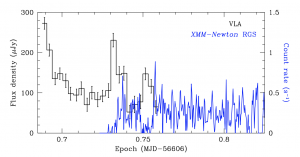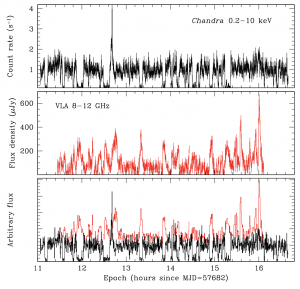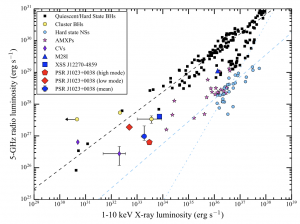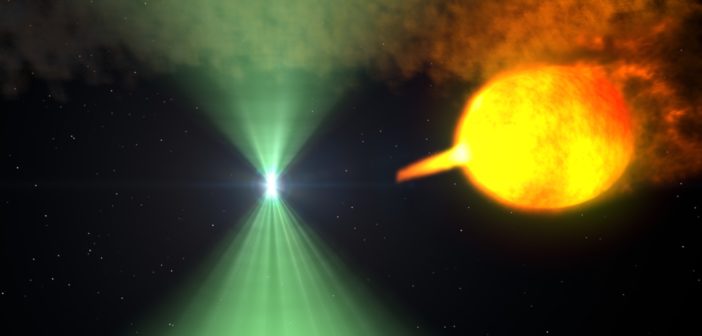Editor’s note: Astrobites is a graduate-student-run organization that digests astrophysical literature for undergraduate students. As part of the partnership between the AAS and astrobites, we occasionally repost astrobites content here at AAS Nova. We hope you enjoy this post from astrobites; the original can be viewed at astrobites.org!
Title: Simultaneous Chandra and VLA Observations of the Transitional Millisecond Pulsar PSR J1023+0038: Anti-correlated X-ray and Radio Variability
Authors: Slavko Bogdanov, Adam T. Deller, James C. A. Miller-Jones, et al.
First Author’s Institution: Columbia University
Status: Submitted to ApJ, open access
What’s more interesting than a rapidly spinning neutron star that emits electromagnetic radiation parallel to its magnetic poles? One that doesn’t exactly behave as expected, of course. One such weirdly acting pulsar, PSR J1023+0038, is a transitional millisecond pulsar (tMSP) — which is fancy speak for a pulsar with a millisecond rotational period that switches between radio and X-ray emission on a several-year timescale. The fact that this pulsar emits in both X-ray and radio on these longer timescales isn’t what piques the interest of astronomers, however, in the case of the study in this astrobite.
Weird Pulsar Behavior

Figure 1: Radio emissions (black) and x-ray emissions (blue) recorded by the VLA and Chandra respectively over time. This shows that when radio emissions drop off, X-ray emissions pick up.
Pulsars can typically fall into one of the following categories: radio pulsars are powered by exchanging rotational energy from the spinning neutron star into emitting radiation. This means that their rotation slows and their pulse length increases. Meanwhile, X-ray pulsars are accretion powered, meaning they turn heated infalling matter into X-ray emission. What distinguishes PSR J1023+0038 from the background of pulsars that switch between accretion-powered X-ray and rotation-powered radio pulsars is that it has a simultaneous anti-correlated X-ray and radio emission. The authors looked at about 5 hours of overlapping and concurrent observations from the Chandra X-ray Observatory and the Very Large Array (VLA) to try and understand this weird relationship between the X-ray and radio emissions. This is very clearly shown in Fig. 1 where we can see a tiny sample of time of overlapping X-ray and radio flux measurements. The anti-correlation is quite strong, meaning that when the X-ray emissions are weakest, the radio emission is strongest.

Figure 2: (Top) Chandra x-ray observations over a period of 5 hours.The 3 x-ray modes can be seen as the one large peak (~12.7 hrs), the low (minima), and high (steady maxima). (Middle) The simultaneous observation as seen from the VLA. (Bottom) The overlapped top and middle observations show the anti-correlation between x-ray and radio emissions.
But wait…there’s more! When we zoom out on the flux/time series observations (Fig. 2) we can not only see that the anti-correlation is persistent, but we can also see that the X-ray emission has at least 3 unique modes of operation. The authors classify these X-ray emission modes as (1) sporadic flaring (~12.7 hrs in Fig. 2), (2) high, and (3) low modes. The difference between high and low in this context is the magnitude of the luminosity.
Trying to Explain Away the Strangeness
This complex and weird behavior unfortunately does not come with an easy or readily available answer. What we know about pulsars and how we can model pulsar accretion doesn’t shed any new light on the situation. The authors do suggest that the switching between high and low modes might occur due to a changing unstable magnetosphere. They also propose that the increase in radio emission can be explained by an outflow of plasma that emits synchrotron radiation as it travels. Additionally, when comparing PSR J1023+0038 to a low-mass X-ray-emitting binary black hole (BH LMXB) (Fig. 3), we can see that the low mode of this tMSP falls into the binary BH region. This is unusual because there is a pretty clear separation between the X-ray/radio luminosity relationship of neutron stars and BHs. Knowing this now, it may call into question whether some BH LMXBs could have been misidentified.

Figure 3: PSR J1023+0038 low (red diamond) and high (red pentagon) X-ray modes closely follow the accreting low-mass X-ray binary black hole systems, making it indistinguishable in the low mode.
Now you may be asking, “so what did we actually discover?”, which is a completely valid question. Well for one, we learned that there in fact do exist strange and unique pulsars that exhibit odd behavior. But the more exciting result is that we may not have a great understanding of pulsars in general. This is exciting because it can spur new astrophysical theories and models; ones that can more generally explain even the weirdest behaviors. Like most of astronomy (and science in general) however, before we can fully claim any specific mechanism for causing the anti-correlated X-ray and radio emissions and the switching between emission modes, we’ll probably need more observations.
About the author, Joshua Kerrigan:
I’m a 3rd Year PhD student at Brown University studying the early universe through the 21cm neutral hydrogen emission. I do this by using radio interferometer arrays such as the Precision Array for Probing the Epoch of Reionization (PAPER) and the Hydrogen Epoch of Reionization Array (HERA).

1 Comment
Pingback: Observing a Strange Pulsar in X-ray and Radio – MeasurementDataBases for Industry & Science